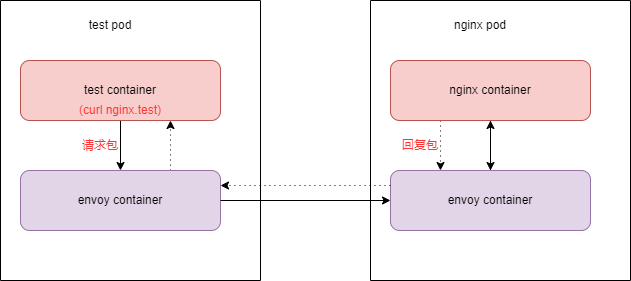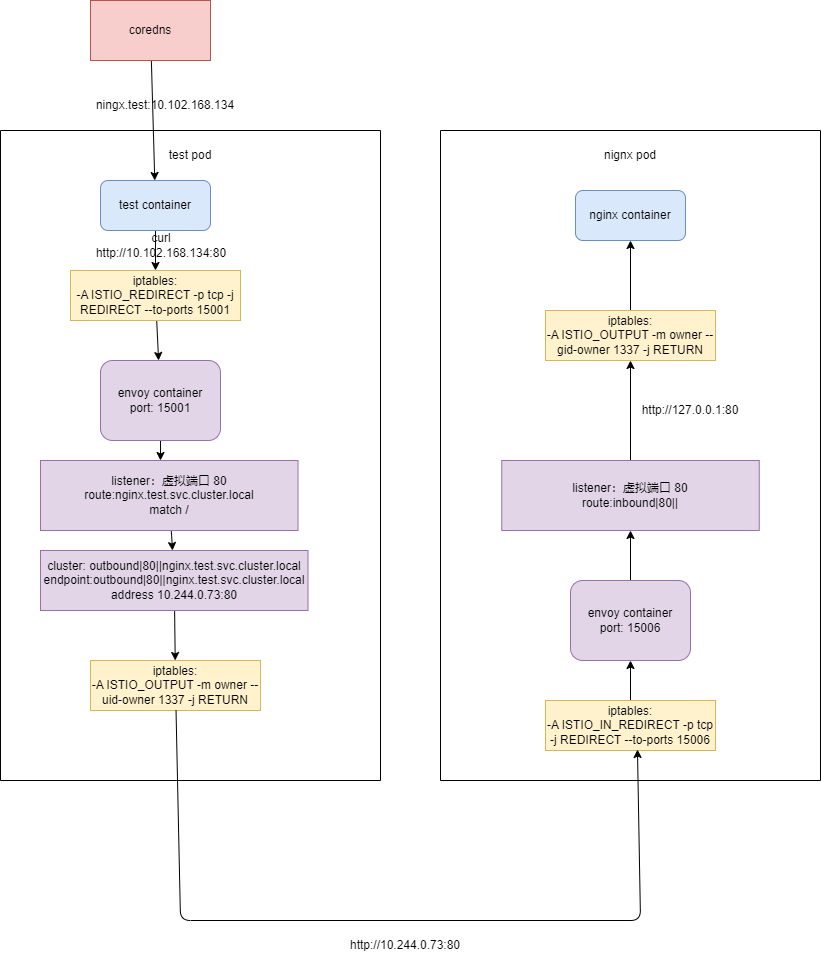Istio 是一个开放源代码的服务网格,它为基于微服务的应用程序提供了一种统一的方式来连接、保护、监控和管理服务。Istio 主要解决的是在微服务架构中的服务间通信的复杂性问题,它通过提供服务间的负载均衡、服务到服务的认证、监控以及服务的弹性(例如重试、熔断等)来实现。
sidecar 是一种设计模式,它将挂在业务容器旁边作为辅助,当业务接受流量和传出流量的时候,都先经过 sidecar 然后在到达业务容器或者发出。sidecar 可以看作是一个代理,或者是一个专门为我一个服务而工作的 gateway。这样,服务的熔断、限流、监控、日志等功能都可以在 sidecar 中实现,而不需要在业务容器中实现。从而实现了业务容器的轻量化,只需要关注业务逻辑。
在 istio 中,sidecar 使用的是 envoy,envoy 是一个高性能的代理,它支持 http1.1, http2, grpc, tcp 等协议,支持负载均衡,熔断,限流,监控等功能。envoy 是一个 c++ 项目,它的性能非常好。通过 istiod 控制平面,使用 grpc stream 的方式更新 envoy 的配置,从而实现了动态配置。

如果在 pod test 中访问 test namespace 下的 nginx service,那么流量会经过自己的 sidecar,然后到达 nginx 的 sidecar,最后到达 nginx 的容器。nginx 回复同样如此,先到达 sidecar,然后到达 test 的 sidecar,最后到达 test 的容器。
在 kubernetes 中,当 namespace 存在 istio-injection=enabled label,那么在该 namespace 中的 pod 在启动的时候,istio 就会利用 mutating addmission webhook 的方式,自动修改 pod spec ,把 containers 中加入 sidecar 容器。当然,它也加入了一个 initcontainer,目的是做一些网络配置,能做到这个的原因是,kubernetes 的 pod 的多个 container 是使用同一个 linux network namespace, 所以 initcontainer 修改的网络配置对所有的 container 都生效。
在 test 访问 nginx 的例子中,我们可以看到 nginx 的容器是启动在 80 端口上的,流量也是访问的 80, sidecar 是怎么劫持到的呢?而且,在 test pod 中,我们访问的是 nginx 的 service,流量又是怎么劫持到 sidecar 的呢?
刚刚说过,pod 除了被插入了一个 sidecar 容器,还被插入了一个 initcontainer,我们启动一个 nginx pod 和 service 看一下。
apiVersion: apps/v1
kind: Deployment
metadata:
name: nginx
namespace: test
spec:
replicas: 1
selector:
matchLabels:
app: nginx
template:
metadata:
labels:
app: nginx
spec:
containers:
- name: nginx
image: nginx:latest
ports:
- containerPort: 80
---
apiVersion: v1
kind: Service
metadata:
name: nginx
namespace: test
spec:
selector:
app: nginx
ports:
- protocol: TCP
port: 80
targetPort: 80
type: ClusterIP
kubectl create ns test
kubectl label namespace test istio-injection=enabled # 开启 istio 注入
kubectl -n test apply -f nginx.yaml
现在我们看一下 nginx pod 被插入的 sidecar 和 initcontainer
## sidecar
- args:
- proxy
- sidecar
- --domain
- $(POD_NAMESPACE).svc.cluster.local
- --proxyLogLevel=warning
- --proxyComponentLogLevel=misc:error
- --log_output_level=default:info
# ...
## intcontainer
- args:
- istio-iptables
- -p
- "15001"
- -z
- "15006"
- -u
- "1337"
- -m
- REDIRECT
- -i
- '*'
- -x
- ""
- -b
- '*'
- -d
- 15090,15021,15020
- --log_output_level=default:info
可以看到,initcontainer 是自动执行了一系列的脚本,这个脚本我们并不知道是做啥的,但是从名字可以看出来是 iptables 的操作,那么我们看一下 iptables 的规则
这里我们容器内没有 iptables,所以我们在宿主机上查看 在nginx pod 所在的主机上查看,先确定 nginx 这个container 的 pid。
# 从 pod 的 status 中的容器的 uid
kubectl get pod -n test nginx-7c79c4bf97-7985c -o jsonpath='{.status.containerStatuses[0].container
ID}'
docker://b0d6c9060661e0912a35d33ff220e67a628c9fc5300ca3c67dc30f9e40c9e0ce%
# 我这里是用 docker 作为 container runtime 的
# 如果你是 containerd 的话 需要执行 ctr -n k8s.io info [container_id] |grep -i pod
docker inspect b0d6c9060661e0912a35d33ff220e67a628c9fc5300ca3c67dc30f9e40c9e0ce | grep -i pid # 在 nginx 所在的主机上执行
"Pid": 4652
# 在主机上使用 nseneter 进入容器的 network namespace 查看 iptables 规则
nsenter -t 4652 -n -- iptables-save
# Warning: iptables-legacy tables present, use iptables-legacy-save to see them
# 说明这个容器使用的是 iptables-legacy 我们按提示执行
nsenter -t 4652 -n -- iptables-legacy-save
# Generated by iptables-save v1.8.7 on Sun May 12 05:53:29 2024
*nat
:PREROUTING ACCEPT [54:3240]
:INPUT ACCEPT [54:3240]
:OUTPUT ACCEPT [49:4198]
:POSTROUTING ACCEPT [49:4198]
:ISTIO_INBOUND - [0:0]
:ISTIO_IN_REDIRECT - [0:0]
:ISTIO_OUTPUT - [0:0]
:ISTIO_REDIRECT - [0:0]
# 所有入栈流量都走 ISTIO_INBOUND 链
-A PREROUTING -p tcp -j ISTIO_INBOUND
# 所有出栈流量都走 ISTIO_OUTPUT 链
-A OUTPUT -p tcp -j ISTIO_OUTPUT
# 忽略(也就是不劫持)目标端口是 15008 15090 15021 15020 的流量
# 15008:隧道端口 15090:prometheus 端口 15021:健康检查 15020:管理端口
# 官方文档端口介绍 https://istio.io/latest/docs/ops/deployment/requirements/#ports-used-by-istio
-A ISTIO_INBOUND -p tcp -m tcp --dport 15008 -j RETURN
-A ISTIO_INBOUND -p tcp -m tcp --dport 15090 -j RETURN
-A ISTIO_INBOUND -p tcp -m tcp --dport 15021 -j RETURN
-A ISTIO_INBOUND -p tcp -m tcp --dport 15020 -j RETURN
# 如果是 tcp 协议就走 ISTIO_IN_REDIRECT 链
-A ISTIO_INBOUND -p tcp -j ISTIO_IN_REDIRECT
# 如果是 tcp 就使用 dnat 把流量转发到15006端口(也就是修改tcp的目标端口)也就是交给envoy处理
-A ISTIO_IN_REDIRECT -p tcp -j REDIRECT --to-ports 15006
# 回环地址 不处理
-A ISTIO_OUTPUT -s 127.0.0.6/32 -o lo -j RETURN
# 从 lo(回环) 口出来的 目标不是本机 owner是 envoy(--uid-owner 1337) 目标端口是 15008 的 转到 ISTIO_IN_REDIRECT 链处理
-A ISTIO_OUTPUT ! -d 127.0.0.1/32 -o lo -p tcp -m tcp ! --dport 15008 -m owner --uid-owner 1337 -j ISTIO_IN_REDIRECT
# 从 lo 口出来的 owner 不是 envoy(不是 envoy 发出的) 不处理
-A ISTIO_OUTPUT -o lo -m owner ! --uid-owner 1337 -j RETURN
# owner 是 envoy 的不处理 (不能劫持自己发出去的流量)
-A ISTIO_OUTPUT -m owner --uid-owner 1337 -j RETURN
# 从 lo(回环) 口出来的 目标不是本机 owner是 envoy(--gid-owner 1337) 目标端口是 15008 的 转到 ISTIO_IN_REDIRECT 链处理
-A ISTIO_OUTPUT ! -d 127.0.0.1/32 -o lo -p tcp -m tcp ! --dport 15008 -m owner --gid-owner 1337 -j ISTIO_IN_REDIRECT
# 从 lo(回环) 口出来的 owner 不是 envoy 不处理
-A ISTIO_OUTPUT -o lo -m owner ! --gid-owner 1337 -j RETURN
# owner 是 envoy 不处理
-A ISTIO_OUTPUT -m owner --gid-owner 1337 -j RETURN
# 目标地址是 127.0.0.1 不处理
-A ISTIO_OUTPUT -d 127.0.0.1/32 -j RETURN
# 剩下转到 ISTIO_REDIRECT 链
-A ISTIO_OUTPUT -j ISTIO_REDIRECT
# 如果是 tcp 就使用 dnat 把流量转发到 15001 端口(也就是修改tcp的目标端口)也就是交给envoy处理
-A ISTIO_REDIRECT -p tcp -j REDIRECT --to-ports 15001
COMMIT
# Completed on Sun May 12 05:53:29 2024
为什么 --uid-owner 1337 和 --gid-owner 1337 就代表 owner 是 envoy 呢?
因为 envot (istio proxy) 是以 uid 和 gid 起来的。
kubectl get pod -n test nginx-7c79c4bf97-7985c -o jsonpath='{.spec.containers[1].name}'
istio-proxy
kubectl get pod -n test nginx-7c79c4bf97-7985c -o jsonpath='{.spec.containers[1].securityContext.ru
nAsGroup}'
1337
kubectl get pod -n test nginx-7c79c4bf97-7985c -o jsonpath='{.spec.containers[1].securityContext.runAsUser}'
1337
每个 pod 中的 iptables 都是一样的,这样我们就知道了 test pod 是怎么劫持的,比如现在在 test pod container 中 curl nginx.test 首先查询 dns nginx.test 对应的 ip 是 10.102.168.134, 访问也就是向 http://10.102.168.134:80 发请求。
http://10.244.0.73:80(pod ip) (具体是怎么转发的后续会介绍到)所以可以看到,流量从 test pod 的 test container 出来之后,会被自己的 envoy(istio-proxy sidecar) 劫持,然后7层转发到 10.244.0.73 (nigix pod IP地址)。然后 nginx pod 中的 envoy container 会劫持这个流量交给自己,然后7层代理到 nginx container。流量回复回去是一个道理。
在上方的流程中 test envoy 劫持到 http://10.102.168.134:80 会转发到 http://10.244.0.73:80,那么他是怎么知道要转发到这里去的呢?如果是 nginx 我们会配置 upstream,然后执行 nginx -s reload,这是 nginx 不支持动态加载方式。envoy 是支持动态加载的,对外提供 API,我们调用 API 就可以动态的修改配置。这个 API 就是 xDS API。它包括了以下API:
listener + route 是用来表达监听哪个端口和哪些路由的,是 envoy 进入流量的入口。cluster + endpoint 是用来表达集群和集群中的服务的,是 envoy 转发流量的目的地。
那这些 xDS 的配置来自哪呢?
这些 envoy 配置都来自于 istiod,istiod 是 istio 的控制平面,它会使用 grpc stream 的方式,动态的更新 envoy 的配置。istiod 会监听 kubernetes 的资源变化,比如 service, endpoint 和 istio 自己 CRD 等,组合成一个配置,然后定时的推送给 envoy。这样就实现了动态配置。
比如我们这个 service 的配置,查看 service 和 endpoints 就知道 service clusterIp 对应的 pod ip。
kubectl -n test get svc nginx
NAME TYPE CLUSTER-IP EXTERNAL-IP PORT(S) AGE
nginx ClusterIP 10.102.168.134 <none> 80/TCP 112m
kubectl -n test get endpoints nginx
NAME ENDPOINTS AGE
nginx 10.244.0.73:80 112m
这样我们就知道了 nginx service 对应的 clusterIp 是 10.102.168.134, 而对应的 pod ip 是 10.244.0.73。然后 istiod 把这个配置推送给所有 sidecar,这样 test pod 中的 envoy 就知道了要把流量转发到 10.244.0.73 了。
在 test pod 的 test 容器中 执行 curl http://nginx.test 流量的流程图如下

我们可以通过调用 pod 中的 envoy 的 admin api 来查看配置
kubectl port-forward pod/nginx-7c79c4bf97-7985c 15000:15000
curl http://localhost:15000/config_dump
打印出的 json 格式的配置文件,它而很大看起来很不方便,幸好 istio 给我们提供了一个工具 istioctl,我们可以使用 istioctl 来查看配置。
因为我们流量是从 test pod 到 nginx pod,所以所限我们查看 test pod 中的 envoy 的配置。
1.首先我们看下 listerner 15001 的配置 因为从 iptables 我们知道 出去的流量会被劫持到 15001
istioctl -n test proxy-config listener test-f5b5d48b5-qdzft --port 15001
ADDRESSES PORT MATCH DESTINATION
0.0.0.0 15001 ALL PassthroughCluster
0.0.0.0 15001 Addr: *:15001 Non-HTTP/Non-TCP
首先会监听 15001 端口,这个是真是监听的端口。它会转发到虚拟端口(Virtual Port),虚拟端口不会真是监听操作系统端口,它只是envoy的逻辑端口。那我们怎么知道流量转发到哪个虚拟端口了?请求的端口是什么,就转发到哪个了。比如我们请求的是 nginx 80 端口,就会转发到 80 虚拟端口
2.查看 listener 的虚拟端口,nginx service ip 10.102.168.134 prot 80
istioctl -n test proxy-config listener test-f5b5d48b5-qdzft --port 80 --address 10.102.168.134
ADDRESSES PORT MATCH DESTINATION
10.102.168.134 80 Trans: raw_buffer; App: http/1.1,h2c Route: nginx.test.svc.cluster.local:80
10.102.168.134 80 ALL Cluster: outbound|80||nginx.test.svc.cluster.local
第一条是明文而且是 http/1.1 或者 h2c 无加密的 http/2)协议的流量会被转发到 nginx.test.svc.cluster.local:80
3.查看 route 配置
istioctl -n test proxy-config route test-f5b5d48b5-qdzft |grep nginx.test.svc.cluster.local
nginx.test.svc.cluster.local:80 nginx.test.svc.cluster.local:80 * /*
80 nginx.test.svc.cluster.local:80 nginx, nginx.test + 1 more... /*
这里我们没有指定 host 所以走第一条
# istioctl -n test proxy-config route test-f5b5d48b5-qdzft --name nginx.test.svc.cluster.local:80 -oyaml
- ignorePortInHostMatching: true
maxDirectResponseBodySizeBytes: 1048576
name: nginx.test.svc.cluster.local:80
validateClusters: false
virtualHosts:
- domains:
- '*'
includeRequestAttemptCount: true
name: nginx.test.svc.cluster.local:80
routes:
- decorator:
operation: nginx.test.svc.cluster.local:80/*
match:
prefix: /
name: default
route:
cluster: outbound|80||nginx.test.svc.cluster.local
maxGrpcTimeout: 0s
retryPolicy:
hostSelectionRetryMaxAttempts: "5"
numRetries: 2
retriableStatusCodes:
- 503
retryHostPredicate:
- name: envoy.retry_host_predicates.previous_hosts
typedConfig:
'@type': type.googleapis.com/envoy.extensions.retry.host.previous_hosts.v3.PreviousHostsPredicate
retryOn: connect-failure,refused-stream,unavailable,cancelled,retriable-status-codes
timeout: 0s
可以看到,match 的路由是 prefix 是 /,也就是所有的请求都会走这个路由,这个路由会把流量转发到 outbound|80||nginx.test.svc.cluster.local 这个 cluster 中。
4.我们查看 cluster
# istioctl -n test proxy-config cluster test-f5b5d48b5-qdzft --fqdn "outbound|80||nginx.test.svc.cluster.local" -oyaml
- circuitBreakers:
thresholds:
- maxConnections: 4294967295
maxPendingRequests: 4294967295
maxRequests: 4294967295
maxRetries: 4294967295
trackRemaining: true
commonLbConfig:
localityWeightedLbConfig: {}
connectTimeout: 10s
edsClusterConfig:
edsConfig:
ads: {}
initialFetchTimeout: 0s
resourceApiVersion: V3
serviceName: outbound|80||nginx.test.svc.cluster.local
filters:
- name: istio.metadata_exchange
typedConfig:
'@type': type.googleapis.com/udpa.type.v1.TypedStruct
typeUrl: type.googleapis.com/envoy.tcp.metadataexchange.config.MetadataExchange
value:
enable_discovery: true
protocol: istio-peer-exchange
lbPolicy: LEAST_REQUEST
metadata:
filterMetadata:
istio:
services:
- host: nginx.test.svc.cluster.local
name: nginx
namespace: test
name: outbound|80||nginx.test.svc.cluster.local
transportSocketMatches:
- match:
tlsMode: istio
name: tlsMode-istio
transportSocket:
name: envoy.transport_sockets.tls
typedConfig:
'@type': type.googleapis.com/envoy.extensions.transport_sockets.tls.v3.UpstreamTlsContext
commonTlsContext:
alpnProtocols:
- istio-peer-exchange
- istio
combinedValidationContext:
defaultValidationContext:
matchSubjectAltNames:
- exact: spiffe://cluster.local/ns/test/sa/default
validationContextSdsSecretConfig:
name: ROOTCA
sdsConfig:
apiConfigSource:
apiType: GRPC
grpcServices:
- envoyGrpc:
clusterName: sds-grpc
setNodeOnFirstMessageOnly: true
transportApiVersion: V3
initialFetchTimeout: 0s
resourceApiVersion: V3
tlsCertificateSdsSecretConfigs:
- name: default
sdsConfig:
apiConfigSource:
apiType: GRPC
grpcServices:
- envoyGrpc:
clusterName: sds-grpc
setNodeOnFirstMessageOnly: true
transportApiVersion: V3
initialFetchTimeout: 0s
resourceApiVersion: V3
tlsParams:
tlsMaximumProtocolVersion: TLSv1_3
tlsMinimumProtocolVersion: TLSv1_2
sni: outbound_.80_._.nginx.test.svc.cluster.local
- match: {}
name: tlsMode-disabled
transportSocket:
name: envoy.transport_sockets.raw_buffer
typedConfig:
'@type': type.googleapis.com/envoy.extensions.transport_sockets.raw_buffer.v3.RawBuffer
type: EDS
typedExtensionProtocolOptions:
envoy.extensions.upstreams.http.v3.HttpProtocolOptions:
'@type': type.googleapis.com/envoy.extensions.upstreams.http.v3.HttpProtocolOptions
useDownstreamProtocolConfig:
http2ProtocolOptions: {}
httpProtocolOptions: {}
可以看到,这个 cluster 是一个 EDS 类型的 cluster,它会从 edsConfig 中获取配置。
5.查看 endpoint
# istioctl -n test proxy-config endpoint test-f5b5d48b5-qdzft --cluster "outbound|80||nginx.test.svc.cluster.local" -oyaml
- addedViaApi: true
circuitBreakers:
thresholds:
- maxConnections: 4294967295
maxPendingRequests: 4294967295
maxRequests: 4294967295
maxRetries: 4294967295
- maxConnections: 1024
maxPendingRequests: 1024
maxRequests: 1024
maxRetries: 3
priority: HIGH
edsServiceName: outbound|80||nginx.test.svc.cluster.local
hostStatuses:
- address:
socketAddress:
address: 10.244.0.73
portValue: 80
healthStatus:
edsHealthStatus: HEALTHY
locality: {}
stats:
- name: cx_connect_fail
- name: cx_total
- name: rq_error
- name: rq_success
- name: rq_timeout
- name: rq_total
- name: cx_active
type: GAUGE
- name: rq_active
type: GAUGE
weight: 1
name: outbound|80||nginx.test.svc.cluster.local
observabilityName: outbound|80||nginx.test.svc.cluster.local
从 endpoint 中我们可以看到,流量会转发到 10.244.0.73:80 这个地址。因为我们这个 service 只有一个 pod,如果多个 pod 的话,会有多个 address。
envoy 会向访问 http://10.244.0.73:80,那么接下来就是 nginx pod 中的 envoy 会把流量转发到 nginx container 中。
6.server 劫持到15006
istioctl -n test proxy-config listener nginx-7c79c4bf97-7985c --port 15006
ADDRESSES PORT MATCH DESTINATION
0.0.0.0 15006 Addr: *:15006 Non-HTTP/Non-TCP
0.0.0.0 15006 Trans: tls; App: istio-http/1.0,istio-http/1.1,istio-h2; Addr: 0.0.0.0/0 InboundPassthroughClusterIpv4
0.0.0.0 15006 Trans: raw_buffer; App: http/1.1,h2c; Addr: 0.0.0.0/0 InboundPassthroughClusterIpv4
0.0.0.0 15006 Trans: tls; App: TCP TLS; Addr: 0.0.0.0/0 InboundPassthroughClusterIpv4
0.0.0.0 15006 Trans: raw_buffer; Addr: 0.0.0.0/0 InboundPassthroughClusterIpv4
0.0.0.0 15006 Trans: tls; Addr: 0.0.0.0/0 InboundPassthroughClusterIpv4
0.0.0.0 15006 Trans: tls; App: istio-http/1.0,istio-http/1.1,istio-h2; Addr: *:80 Cluster: inbound|80||
0.0.0.0 15006 Trans: raw_buffer; App: http/1.1,h2c; Addr: *:80 Cluster: inbound|80||
0.0.0.0 15006 Trans: tls; App: TCP TLS; Addr: *:80 Cluster: inbound|80||
0.0.0.0 15006 Trans: raw_buffer; Addr: *:80 Cluster: inbound|80||
0.0.0.0 15006 Trans: tls; Addr: *:80 Cluster: inbound|80||
listener 的虚拟端口
istioctl -n test proxy-config listener nginx-7c79c4bf97-7985c --port 80 --address 0.0.0.0
ADDRESSES PORT MATCH DESTINATION
0.0.0.0 80 Trans: raw_buffer; App: http/1.1,h2c Route: 80
0.0.0.0 80 ALL PassthroughCluster
所以 DESTINATION 是 Route: 80 ,所以 route 会匹配 inbound|80||
7.查看 server route
# istioctl -n test proxy-config route nginx-7c79c4bf97-7985c --name "inbound|80||" -oyaml
- name: inbound|80||
validateClusters: false
virtualHosts:
- domains:
- '*'
name: inbound|http|80
routes:
- decorator:
operation: nginx.test.svc.cluster.local:80/*
match:
prefix: /
name: default
route:
cluster: inbound|80||
maxStreamDuration:
grpcTimeoutHeaderMax: 0s
maxStreamDuration: 0s
timeout: 0s
- name: inbound|80||
validateClusters: false
virtualHosts:
- domains:
- '*'
name: inbound|http|80
routes:
- decorator:
operation: nginx.test.svc.cluster.local:80/*
match:
prefix: /
name: default
route:
cluster: inbound|80||
maxStreamDuration:
grpcTimeoutHeaderMax: 0s
maxStreamDuration: 0s
timeout: 0s
会匹配到 cluster inbound|80||,它是 inbound 类型的 route, 所以它会直接把流量转发到 80 端口。也就是 pod 中 nginx container 中的 nigix 进程。
7.回复
当 nginx 把静态资源回复给 test 的时候,流量的方式和请求的时候是一样的,只是方向相反。